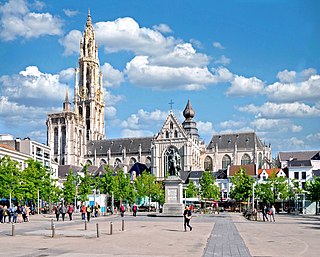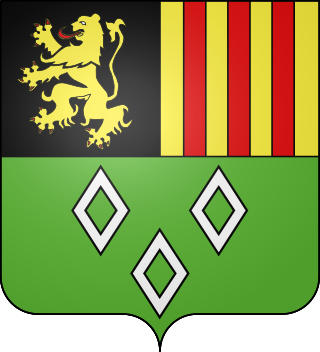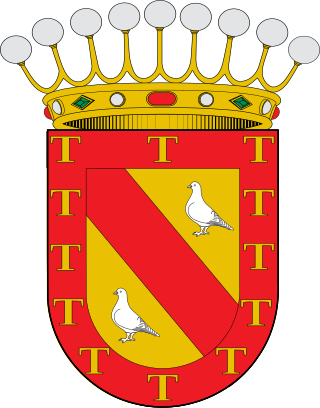| House of Rubens | |
|---|---|
| noble family | |
 | |
| Country | |
| Founded | Peter Paul Rubens |
| Titles | Lords of Vremdyck Lords of Rameyen |





The Rubens family is a Flemish noble family that lived in Antwerp.
| House of Rubens | |
|---|---|
| noble family | |
 | |
| Country | |
| Founded | Peter Paul Rubens |
| Titles | Lords of Vremdyck Lords of Rameyen |





The Rubens family is a Flemish noble family that lived in Antwerp.
The origin is believed to be Arnold (Arnoldus) Rubbens, a tanner, who was born around 1350, who lived in Antwerp and was married to Catherina van den Elshoute. Their son Jan married Margaretha van Catschote, and was the father of three sons: Arnold II, Joost and Peter I. Bartholomaeus I Rubens, born 1501, is recorded as being at the court of Holy Roman Emperor Charles V. He married Barbara Arents, of noble birth. [1] [2]
Most famous are his grandsons, the painter Sir Peter Paul Rubens (knighted in 1624 by Philip IV of Spain and in 1630 by Charles I of England), and his brother Philip Rubens, who entered in the service of Cardinal Ascanio Colonna. Many of their descendants married to important noble families. The main family members were buried in Antwerp in respectively the Saint James' church, Antwerp and the former St. Michael's Abbey.
Today the family is extinct in the male line, but has descendants in the other branches: Goubau-Rubens / van Parys-Rubens / de Lunden-Rubens. It is believed that there are more than 10,000 descendants today, most of them members of the Belgian aristocracy. [3] The last direct male-line descendant of the painter was his grandson Alexander Rubens, Lord of Vremdyck, who died in Mechelen.

The Cathedral of Our Lady is a Roman Catholic cathedral in Antwerp, Belgium. Today's see of the Diocese of Antwerp started in 1352 and, although the first stage of construction was ended in 1521, has never been 'completed'. In Gothic style, its architects were Jan and Pieter Appelmans. It contains a number of significant works by the Baroque painter Peter Paul Rubens, as well as paintings by artists such as Otto van Veen, Jacob de Backer and Marten de Vos. The cathedral is the largest Gothic church in Belgium, with its tower rising 123 meters over the city.

St. James' Church is a former collegiate church in Antwerp, Belgium. The church is built on the site of a hostel for pilgrims to Santiago de Compostela. The present building is the work of the Waghemakere family and Rombout Keldermans, in Brabantine Gothic style. The church contains the grave of Peter Paul Rubens in the eastern chapel.

Isabella Brant was the first wife of the Flemish painter Peter Paul Rubens, who painted several portraits of her.

The Van de Werve family is one of the oldest Belgian noble families from Antwerp that is still in existence.

Sir Peter Paul Rubens was a Flemish artist and diplomat. He is considered the most influential artist of the Flemish Baroque tradition. Rubens's highly charged compositions reference erudite aspects of classical and Christian history. His unique and immensely popular Baroque style emphasized movement, colour, and sensuality, which followed the immediate, dramatic artistic style promoted in the Counter-Reformation. Rubens was a painter producing altarpieces, portraits, landscapes, and history paintings of mythological and allegorical subjects. He was also a prolific designer of cartoons for the Flemish tapestry workshops and of frontispieces for the publishers in Antwerp.

Justus van Egmont or Joost van Egmont was a painter and a tapestry designer during the 17th century. After training in Antwerp with Gaspar van den Hoecke and working with Anthony van Dyck, van Egmont also worked in Peter Paul Rubens' workshop. He moved to France in 1628 where he was a court painter for the House of Orléans. In France he helped to found the Académie de peinture et de sculpture. He later returned to Flanders where he worked in Antwerp and Brussels. He is mainly known for his portrait paintings, although he also painted some history subjects, and produced designs for five different tapestry series.

HelenaFourment was the second wife of Baroque painter Peter Paul Rubens. She was the subject of a few portraits by Rubens, and also modeled for other religious and mythological paintings.

The de Lalaingfamily is a noble family from the south of Flanders which played an important role in the history of the County of Hainaut and of the Netherlands. The current family belongs to the Belgian nobility.
Maria Pypelinckx was a writer from the Southern Netherlands, best known today as the mother of the painter Peter Paul Rubens.

The House of Schetz or Schetz de Grobbendonk, originally House von Schetzenberg is a German Noble House. Most famous is the Flemish branch named Schetz, one of whose members became the first duke of Ursel.

The Goubau family was an important noble family of Antwerp, many of its members are related to other important families.

Nicolaas Rockox (1560–1640), was an art patron and collector, numismatist, humanist, philanthropist and mayor of Antwerp. He was a close personal friend and important patron of Peter Paul Rubens. His residence in Antwerp was a centre where Antwerp's humanists and artists congregated and housed a large collection of artworks, antiques, rare objects and coins. It is now a museum known as the Snijders&Rockox House. He was knighted by Archduke Albert and Isabella, the Governor General of the Habsburg Netherlands.

Philip Rubens (1574–1611), was a Flemish antiquarian, librarian, philologist and city administrator from the Habsburg Netherlands. He was the older brother of the prominent Flemish Baroque painter Peter Paul Rubens.

Nicolaas Peter Paul Rubens, Lord of Rameyen (1618–1655) was a son of the painter Peter Paul Rubens and Isabella Brant.

The House of Spoelberch is an important Belgian noble house. The family was also part of the Nobility of the Holy Roman Empire and today it is legally recognized as being part of the Belgian nobility.

Alexander Joseph Rubens, Lord of Vremdyck, Willenskerk, Ter Schriek, Liesele, Malderen and steenhuffel was a Flemish noble man. He was the last male heir of his grandfather.

Albert Rubens (1614–1657), was the eldest son of Peter Paul Rubens and Isabella Brant. His research as a philologist and scholar of antiquity gained him the recognition of fellow scholars throughout Europe. He held an official position in the government of the Habsburg Netherlands as a secretary of the Privy Council of the Habsburg Netherlands.

The House of Glymes was an old Belgian noble family, an illegitimate branch of the House of Reginarid, which ruled the Duchy of Brabant. Glymes or Glimes is a municipality of Incourt. Their descendants of the branch of Grimberghen are styled as the Prince de Grimberghen.

Coloma or de Coloma or Colomba is an old important Spanish Noble House. A branch belongs to the Flemish nobility, and became the Counts of Bornhem. Other branches became the Counts of Elda, Marquesses of Espinar, Marquesses of Noguera and Marquesses of Canales de Chozas.

Hendrik de Moy was secretary of the Antwerp city council and a historian.